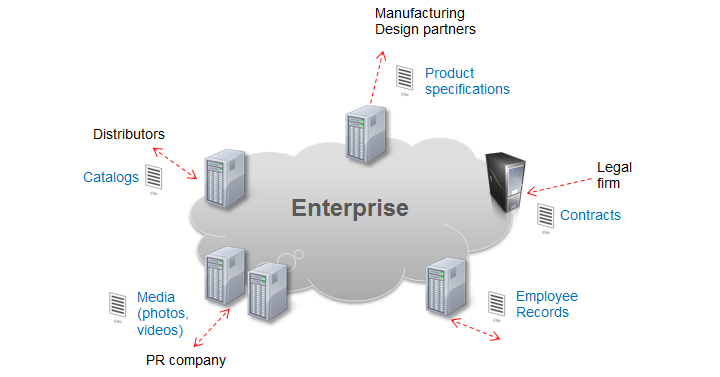With the release of SOA Suite 12c a new product was revealed. The first sighting was at Oracle OpenWorld 2013. On the Fusion Middleware Demo Grounds there was a demo shown where B2B was integrated with a product called Managed File Transfer (shortened as MFT). At that same conference I gave a presentation about this product together with the product manager of MFT, Dave Berry. This blog gives an in-depth look into Managed File Transfer.
There is a growing problem with FTP in the enterprise where there is a lack of control, visibility, security and reliability. The lack of control is due to the uncontrolled proliferation of FTP servers & clients. Departments are creating stand-alone FTP servers and configuring users where needed. There is no central FTP server. Because of this there is no global visibility of the exchange of crucial data files – including customer data. It is highly possible that these FTP servers are not integrated with enterprise security standards where as FTP servers are rarely integrated with directories. Because these FTP servers run stand-alone they are a single point of failure and rarely offer HA capabilities, which effects the reliability. This can be tackled using Managed File Transfer.
What is Managed File Transfer?
MFT is a simple and secure End-to-End Managed File Gateway. At the base MFT uses an “Embedded” (S)FTP / SSH server which support HA clustering. MFT has a scalable architecture, which mean it can easily be expanded by adding another Weblogic node to the cluster. It also includes an extensible framwork for pre/post processing of files. MFT integrates with Standards Based Middleware like (S)FTP, SOA, B2B, Service Bus and Web Services.Managed File Transfer has support file delivery of very large files ~ 500GB+ which can be ZIP compressed/decompressed and encrypted and decrypted using PGP encrypting. One main feature is the possibility to send files via Web Services using Pass-by-Reference (Claim/Check pattern). It can be a reference to a FTP or File location, but there is also inline (base64) support. File transfers can be scheduled and delivery to target endpoints can be paused, resumed and resubmitted. If delivery fails then files can automatically be retried. MFT can send notifications when files are delivered or when transfers fail. Deliveries can be done through HTTP, JCA, FTP or in-memory. Managed File Transfer support (custom) callouts to archive, move and delete files.
Transactions can be audited and monitored using the included Web UI for designing, monitoring and administration of transfers. With this lightweight Web based Design-Time Interface you can easily build, edit and deploy end-to-end transfers. I will go into all the details a bit later on.
Use cases for Managed File Transfer
Internal Business IntegrationApplication to Application File sharing. Managed File Transfer can integrate with SOA / SB.
External Partner Integrations
(s)FTP File gateway outside firewall and Managed File Transfer can integrate with B2B / EDI.
Commercial off-the-shelf/Cloud
OOTB End-to-end delivery channels and Application to Application solutions.
Other use cases include File Management beyond business integration, delivery of media to mobile phones.
Functional Use Case Patterns
Using Managed File Transfer as standalone application:
MFT can transfer files on its own. This can be done using the embedded FTP and sFTP servers and the (local) file systems.
Using Managed File Transfer to integrate with SOA (same pattern goes for SB, SOAP):

Managed File Transfer to integrate with B2B (same pattern goes for Healthcare):

MFT can integrate with a B2B application. B2B can be the source or target of a transfer.
It is also possible to configure a B2B target endpoint in one transfer that is the source of another transfer.
Using Manager File Transfer for Hybrid Integrations:

MFT as a key participant in a web of data transfers, which can include multiple application types like B2B, SOA and file shares.
Read full article on the AMIS Technology Blog.

Thanks for sharing this amazing blog
ReplyDeleteOracle SOA Online Training
SENT our encrypted file transfer app is your best choice to send files of any size to any amount of recipients. We're easier and more secure than any other.
ReplyDeleteTranfer Large Files Free | Secure & Encrypted